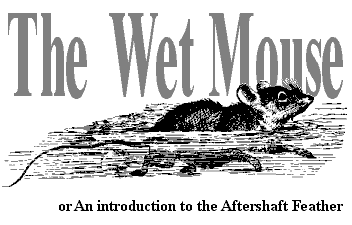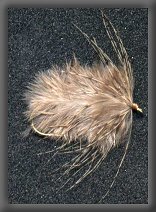Apart from requiring an active imagination and a certain amount of manual dexterity, the art — or craft, if you will — of fly tying demands, perhaps more than any other quality, an understanding of and a feeling for materials: the furs, feathers and folderol and just plain stuff that go into the making of a fly.

At the fly tying bench the fox and the chicken, the wolf and the lamb, finally get to lie down together in peace (or more accurately, pieces, if you'll pardon the pun), joining a host of other birds, animals, or perhaps even synthetic materials that the flytyer will manipulate and use to create if not life, then the imitation of life: the artificial insect, baitfish, crustacean, or some other food that fish will feed on.
Given the wide range of materials available, it's not surprising that flytyer's often develop a fondness for one material over another. Some tyers fall in love with the iridescent beauty of peacock feathers, some with the subtle tones of a blue dun hackle, while others will extol the wonders of a handsomely barred silver fox. Some tyers develop an almost erotic relationship with a certain material and rhapsodize endlessly over how a certain material feels between the fingers when working with it. The list of individual material preferences among fly tyers is a long one and would make an interesting study in itself.
Myself, I've gone through many phases of devotion to a certain material; at times indulging a passion for marabou, at other times squirrel or peacock or raccoon or even for synthetic materials. These passions, like many passions, come and go and then come again at some other time in my life, returning with the seasons of my moods.
When asked, however, to name an "all-time" favorite material for tying, to choose the one material that has always and consistently given me great — if not the greatest — pleasure to work with (and this is a question asked more frequently than you'd think), I almost always answer: the ringneck pheasant. Apart from its qualities of general beauty and common availability, the pheasant is a bird that can be put to almost illimitable uses by the imaginative tyer. Its various feathers can be used — among other uses — for hackle, wings, tails, or for dubbing; to tie large flies or small, wet flies or dries or streamers and nymphs. In fact, I once offered to bet someone that an imaginative (and frugal) tyer could probably tie up over five thousand flies from a single pheasant skin. The bet was a dollar a fly, or five thousand dollars. The bet was never taken up but I'm sure I would have won.
Although every single feather on the pheasant can be used to tie a fly, there is one particular feather found on a pheasant that I have a special fondness for the aftershaft feather (often mistakenly called the filoplume ). This humble, hidden feather — Hypor hachus for the Latin lover — is the downy insulating feather attached to the base of most body feathers not only on the pheasant but on birds throughout the avian world, from partridges to penguins, in a wide range of sizes and colors. On the pheasant the aftershaft feather may be long or short (depending on the size of the body feather it's attached to) but mostly it's a dun-gray plume thick with very soft barbs attached to a pulpy stem that is exceptionally strong at its butt end and extremely weak at its tip. Above all, it's a feather with many uses for the imaginative flytyer.
I had been working with pheasant for years and had handled thousand of aftershaft feathers before I ever gave a thought to putting these feathers to work. Why this was so, I can't really say now, but I do remember the day when I first noticed, really looked at these concealed feathers and began to consider and explore their possibilities.
It was at Slough Creek in the northern part of Yellowstone Park, sometime back in the late 70's, before it became "discovered," when I could camp there forever and in solitude and for nothing. Where I would camp by the creek for weeks on end without seeing another soul or be bothered by a pesky park ranger. Just me and my cat, Merlin. And the trout in the creek. And the wind in the woods in the evening.
My tying table was a piece of planking I had found in the woods and had stretched across two logs that lay along the bank and with just enough room beneath the plank to slide my legs under while I sat on the ground and churned out Pheasant Hoppers as fast as I could for Bud Lilly and his shop in West Yellowstone. This was how I supported myself that summer. Tying Pheasant Hoppers along the banks of Slough
Looking back, I tend now to view that time as an idyll, a peaceful and very pleasant part of my past, but of course there was much more to it than that. I've largely filtered out the memories of a constantly sore back, burning eyes, and the sheer boredom of turning out one fly after another that looked exactly like the ones I had been tying for hours and would tie for hours to come.
One day, after I had tied up three dozen or so or these rather complicated and time-consuming flies and I had begun to be bored with the repetition, my mind began to cast around for something else to think about besides the materials and proportions of a Pheasant Hopper. It was then that I noticed the aftershaft feathers attached to the base of the body feathers that I had been plucking and preparing for the wings on the Pheasant Hopper and wondered why I had never used them before in my tying.
 And so I picked one off the stem of a body feather
and tied it onto the shank of the # 8 long-shank hook in the vise
down near the bend of the hook and wound it on to see what it would
look like, taking one turn in front of the other until I had used
up the whole feather. So far, so good. I liked the way it looked
on the hook and how it felt between my fingers as I wound it on.
And so I tied on another aftershaft feather in front of this one,
then a third and fourth until the entire shank was covered. Without
having thought about it beforehand, I had tied what looked to me
now like a small mouse, a small gray mouse. It even felt like a
mouse when I stroked its body with my forefinger. It was a wonder
that the cat didn't pounce on it, it looked so real.
And so I picked one off the stem of a body feather
and tied it onto the shank of the # 8 long-shank hook in the vise
down near the bend of the hook and wound it on to see what it would
look like, taking one turn in front of the other until I had used
up the whole feather. So far, so good. I liked the way it looked
on the hook and how it felt between my fingers as I wound it on.
And so I tied on another aftershaft feather in front of this one,
then a third and fourth until the entire shank was covered. Without
having thought about it beforehand, I had tied what looked to me
now like a small mouse, a small gray mouse. It even felt like a
mouse when I stroked its body with my forefinger. It was a wonder
that the cat didn't pounce on it, it looked so real.
This little hastily-tossed off creature of fluff probably would have found a home in one of the darker corners of my fly box and been eventually forgotten if it hadn't been for the sudden arrival of my friend, Pete Laszlo, who came walking into my camp to remind me that we had planned to fish together that evening. I quickly whip-finished a head onto the mouse-like fly and released it from the jaws of the vise and stuck it onto my lamb's wool vest patch. I gathered up my tools and loose materials and stowed them away in the tent, put down some cat food for Merlin, and headed off with Pete along the trail that led to a favorite stretch of water between the campground and down where the creek emptied into the Lamar.
Once on the stream I plucked the funny-looking fluffy "fly" from my vest patch and tied it to my leader. I had no intention of fishing it but I was rather curious to see what the material looked like when wet and so I dropped it into the water at my feet and swished it around a bit to soak it so that it would sink quickly (aftershaft feathers are fairly buoyant until soaked).
Looking at the fly as it swam in the slow current around my waders, I was amazed. It seemed that a heart was beating beneath those feathers: every fiber simply trembled with movement and life. It didn't look like anything in particular but it looked alive. It might even catch a fish. Well, we'd soon find out.
I worked out some line and cast the fly tight in to the opposite bank and let it sink and swim a few feet downstream and into the dark water near where the bank was undercut and about to cave in, where I knew a good cutthroat could almost always be found. The angle of the setting sun was just right and I could see the fly well as it drifted just a foot or so below the surface. A few seconds later I could see also that it was being followed. The large cutthroat had left its lair and was slowly closing in on the fly. I twitched the fly once and then twice. On the third twitch the trout grabbed it and turned.
There was no need to set the hook; the fish did all the work, swallowing the fly deeply and turning sharply in a quick dash upstream and back into its lair. Cutthroat aren't generally known for their fighting abilities but this one hadn't heard the word and it was several minutes before I was able to land the fish, all twenty-three inches of vermilion, scarlet and gold. I returned the fish to the creek, lit a cigarette, and sat down on the bank to savor the experience.
The caddis were starting to come off now and up and down the creek the trout were beginning to rise. I would probably catch more fish, I thought, if I switched to a more representative caddis pattern but I've always enjoyed experimenting with the unusual or the new rather than going with a sure thing and so I decided to stay with my fluffy little nondescript fly, my new toy, so to speak, and I stayed with this fly for the rest of the evening. By the time the sun had gone down and it was time to head back to camp I had taken more than a dozen fish (mostly rainbows and several cutthroat), all on this bedraggled little fly tied with aftershaft feathers.
Since that first day on Slough Creek, I've fished this simple fly (which I soon dubbed the Wet Mouse) with consistent success in many different types of water throughout the world. While I call the fly a Wet Mouse — simply because that is how I first thought of it — its ovoid shape probably suggests as often as not the shape of a dragonfly nymph or maybe even a snail as much as a mouse and I now tie the fly up in a number of sizes and colors (the feather takes a dye nicely). I often tie it up now with a collar of pheasant or partridge, to suggest legs or maybe even whiskers, and I fish each version in a manner consistent with the movement (or non-movement, in the case of the snail) of each of these creatures.
I've had the most consistent success with this fly when fishing slow-moving meadow streams and in lakes and ponds, probably because it's in these waters that one is most likely to find significant populations of dragonflies and also the occasional hapless meadow mouse or vole. But the fly is also exceptionally productive in faster waters as well, especially where snails are found in abundance — I think of the Upper Madison, near Madison Junction — where I've fished the Wet Mouse (in its original, unadorned state, sans collar) with great success for the rainbows who are especially fond of these snails.
Over the years the Wet Mouse has become one of my favorite flies to tie and to fish, not only because of its simple beauty and it fish-taking ability but perhaps also because it reminds me of a long-ago summer day at Slough Creek when I first began to appreciate the aftershaft feather and to consider and explore its many charms and uses. It was the beginning of a long love affair with a feather. I'm just an old sentimentalist, I guess.
Dressing for the Wet Mouse
|
Hook: |
M39671 or equivalent 2x long hook, #12 - 4 |
|
Thread: |
6/0, Danville's 6/0, gray or tan |
|
Body: |
Pheasant aftershaft feathers wound completely over shank (size of feather to vary with hook size) |
|
Collar: |
Pheasant back feather, partridge, grouse or long speckled hen hackle. |
Note: In the coming months I'll be writing more about the many other uses of the aftershaft feather, so stay tuned, as they say, and return often. And be sure to tie up a few Wet Mice before you next go fishing.






